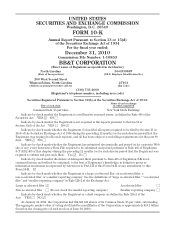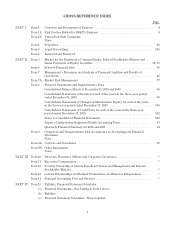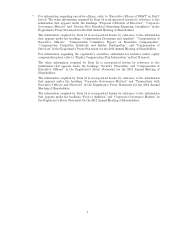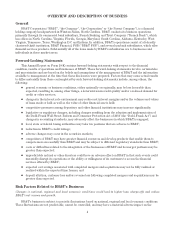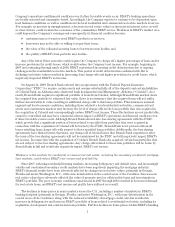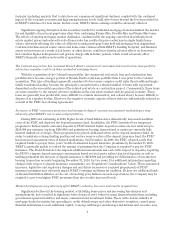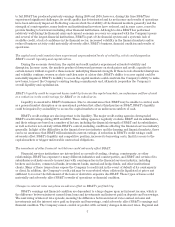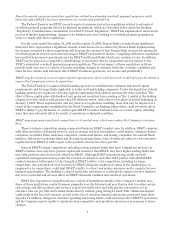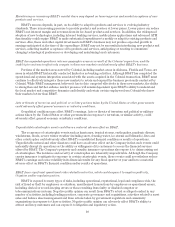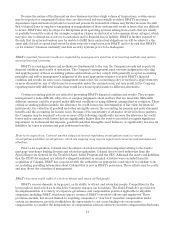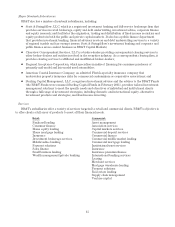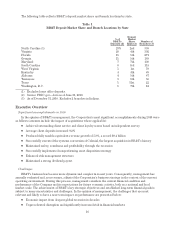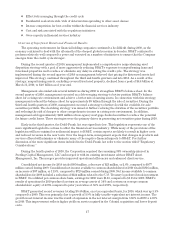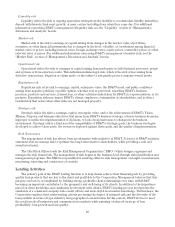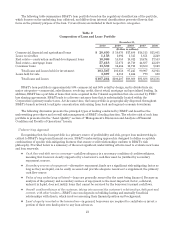BB&T 2010 Annual Report Download - page 11
Download and view the complete annual report
Please find page 11 of the 2010 BB&T annual report below. You can navigate through the pages in the report by either clicking on the pages listed below, or by using the keyword search tool below to find specific information within the annual report.Because the nature of the financial services business involves a high volume of transactions, certain errors
may be repeated or compounded before they are discovered and successfully rectified. BB&T’s necessary
dependence upon automated systems to record and process its transaction volume may further increase the risk
that technical flaws or employee tampering or manipulation of those systems will result in losses that are difficult
to detect. BB&T also may be subject to disruptions of its operating systems arising from events that are wholly
or partially beyond its control (for example, computer viruses or electrical or telecommunications outages), which
may give rise to disruption of service to customers and to financial loss or liability. BB&T is further exposed to
the risk that its external vendors may be unable to fulfill their contractual obligations (or will be subject to the
same risk of fraud or operational errors by their respective employees as is BB&T) and to the risk that BB&T’s
(or its vendors’) business continuity and data security systems prove to be inadequate.
BB&T’s reported financial results are impacted by management’s selection of accounting methods and certain
assumptions and estimates.
BB&T’s accounting policies and methods are fundamental to the way the Company records and reports its
financial condition and results of operations. The Company’s management must exercise judgment in selecting
and applying many of these accounting policies and methods so they comply with generally accepted accounting
principles and reflect management’s judgment of the most appropriate manner to report BB&T’s financial
condition and results. In some cases, management must select the accounting policy or method to apply from two
or more alternatives, any of which may be reasonable under the circumstances, yet may result in the Company
reporting materially different results than would have been reported under a different alternative.
Certain accounting policies are critical to presenting BB&T’s financial condition and results. They require
management to make difficult, subjective or complex judgments about matters that are uncertain. Materially
different amounts could be reported under different conditions or using different assumptions or estimates. These
critical accounting policies include: the allowance for credit losses; the determination of fair value for financial
instruments; the valuation of goodwill and other intangible assets; the accounting for pension and postretirement
benefits and the accounting for income taxes. Because of the uncertainty of estimates involved in these matters,
the Company may be required to do one or more of the following: significantly increase the allowance for credit
losses and/or sustain credit losses that are significantly higher than the reserve provided; recognize significant
impairment on its financial instruments, goodwill and other intangible asset balances; or significantly increase its
liabilities for taxes or pension and post retirement benefits.
Prior to its acquisition, Colonial was the subject of several regulatory investigations and a criminal
investigation and these investigations, which are ongoing, may require significant resources and management
attention.
Prior to its acquisition, Colonial was the subject of a federal criminal investigation relating to the bank’s
mortgage warehouse lending division and related irregularities. Colonial also received subpoenas from the
Special Inspector General for the Troubled Asset Relief Program and the SEC. Although the assets and liabilities
that the FDIC determined are related to alleged fraudulent or criminal activities were excluded from the
acquisition of Colonial, BB&T has cooperated with the authorities as appropriate (and expects to continue to do
so), including providing information about Colonial that is now in BB&T’s possession. These efforts may be costly
and may divert the attention of management.
BB&T’s business could suffer if it fails to attract and retain skilled people.
BB&T’s success depends, in large part, on its ability to attract and retain key people. Competition for the
best people in most activities in which the Company engages can be intense. The Dodd-Frank Act provides for
the implementation of a variety of corporate governance and compensation practices applicable to all public
companies, including BB&T, which may impact certain of BB&T’s executive officers and employees. These
provisions include, but are not limited to, requiring companies to “claw back” incentive compensation under
certain circumstances, provide stockholders the opportunity to cast a non-binding vote on executive
compensation, to consider the independence of compensation advisors and new executive compensation disclosure
11

